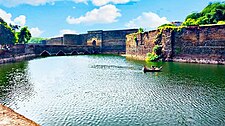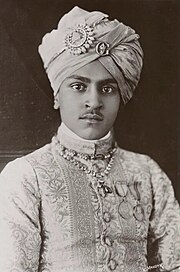Bharatpur | |||||||||
|---|---|---|---|---|---|---|---|---|---|
| 1722–1947 | |||||||||
Bharatpur State in the Imperial Gazetteer of India | |||||||||
| Capital | Bharatpur | ||||||||
| Common languages | Braj Hindi | ||||||||
| Government |
| ||||||||
| Maharaja | |||||||||
• 1722–1756 (first) | Badan Singh | ||||||||
• 1929–1947 (last) | Brijendra Singh | ||||||||
| Historical era | Early-modern India | ||||||||
• Established | 18 November 1722 | ||||||||
| 15 August 1947 | |||||||||
| |||||||||
| Today part of | India · Rajasthan | ||||||||







Bharatpur State was a Princely state under British suzerainty that was ruled by the Sinsinwar clan of the Hindu Jats. At the time of reign of king Suraj Mal (1755–1763) revenue of the state was 17,500,000 Gold coin per annum.[2] The major architecture of this state include Lohagarh Fort and Deeg Palace.
Lohagarh Fort is one of the well-known forts located in Bharatpur city of Rajasthan which was built by Maharaja Suraj Mal in 1732 on an artificial island and took eight years to complete. He is famous for building other such forts and palaces in his kingdom. It needed large number of manpower and significant amount of wealth to build such impregnable fort, as the name of the fort itself says-- "Lohagarh", which means, Iron fort (Loha means Iron and Garh means fort).[3] Lohagarh Fort is considered as one of the strongest fort as British forces led by Lord Lake could not capture it in spite of several attacks during the Siege of Bharatpur. Lord Lake made a siege of the fort in 1805 for six weeks but in spite of so many attacks he couldn’t annex it.[4]
Between December 1825 and January 1826, British troops under Lord Combermere initially surrounded the state's capital until on 18 January 1826 its fortress was stormed and captured. After this siege, Bharatpur became princely state under British Raj control.[5]
Deeg Palace is a Palace in Deeg & 32 km from city of Bharatpur in Deeg District in Rajasthan, India. It was built in 1730 [6] by Maharaja Suraj Mal as a luxurious summer resort for the rulers of Bharatpur State.
- ^ Sunderlal, Pandit (2018). How India Lost Her Freedom. SAGE Publishing. p. 500. ISBN 9789352806423.
- ^ Sen, Sailendra Nath (2010). An Advanced History of Modern India. Macmillan. p. 420. ISBN 978-0-230-32885-3.
- ^ "Lohagarh Fort". 10 February 2024.
- ^ "Lohagarh Fort: कोई नहीं जीत पाया ये किला, 13 बार हमले के बाद अंग्रेज भी हो गए थे असफल". 5 February 2024.
- ^ "Siege of Bharatpur, 1825-1826". 5 May 2024.
- ^ History of Deeg Palace in Bharatpur



